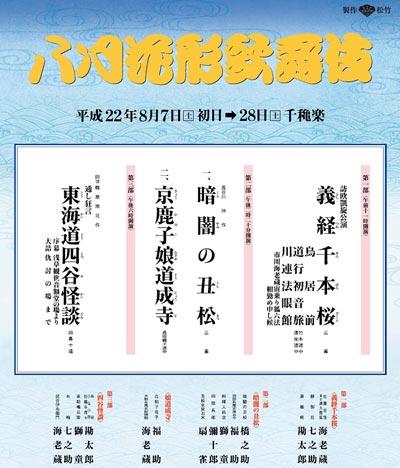| Comments |
Yoshitsune Senbon Zakura:
(Yoshitsune and the Thousand Cherry Trees)
This play was first performed in the Bunraku puppet theatre and is
an epic story about the famous 12th century general Yoshitsune fleeing from the
wrath of his brother Yoritomo, after the end of the war. Although Yoshitsune
is the title character, the main characters of the play are actually different
and this month features the three acts of the play about the magical fox Tadanobu.
Torii Mae:
(In Front of the Fushimi Inari Shrine)
Yoshitsune (Nakamura Kantar˘) is forced to flee from the troops sent by his brother Yoritomo.
The trip will be hard and he decides that he must leave behind his lover
Shizuka Gozen (Nakamura Shichinosuke), despite her passionate pleas to remain with him.
As a reminder of himself, he presents her with a precious hand drum that
he had received from the emperor. Yoshitsune's retainer Tadanobu (Ichikawa Ebiz˘)
rescues Shizuka from Yoritomo's troops and Yoshitsune decides to leave
her in his care.
Michiyuki Hatsune no Tabi:
(Mt. Yoshino)
The story continues with a musical travel scene. Hearing that Yoshitsune has
taken refuge in the mountains of Yoshino, Tadanobu (Ichikawa Ebiz˘)
and Shizuka (Nakamura Shichinosuke) go to try to meet him there. Although Tadanobu keeps
disappearing, he always appears when Shizuka plays the precious drum
that she received from Yoshitsune. In dance Tadanobu recounts
episodes from the Genpei war,
including the battle in which his brother died.
Kawatsura H˘gen Yakata:
(The Mansion of the Priest Kawatsura)
Yoshitsune (Nakamura Kantar˘) has taken refuge in the mountains of Yoshino at the
mansion of an old ally. Tadanobu (Ichikawa Ebiz˘) arrives but has no recollection
of Shizuka being placed under his care. Shizuka (Nakamura Shichinosuke) herself soon arrives
with the other Tadanobu and after an investigation they discover that
he is actually a fox (Ichikawa Ebiz˘). In a touching story, the fox tells how
he took on human form to be close to the hand drum which is made
from the skins of his fox parents. Moved, Yoshitsune gives the fox the
drum and he flies away joyously. This scene features the Kabuki technique of
flying through the air (chűnori).
Kurayami no Ushimatsu: a modern masterpiece by Hasegawa Shin (1884~1963)
first performed in 1934. It shows Ushimatsu, an cook with a very strong sense of
justice who is forced to kill the evil stepmother of his lover Oyone.
Ushimatsu flees, but entrusts Oyone to Shirobŕ, his trusted workmate.
Some years later, he sneaks back into Edo, but on his way, he encounters Oyone
as a prostitute in an inn outside of town. She tries to explain that Shirobŕ
treacherously seduced her and then sold her into prostitution as soon as Ushimatsu
was gone. Ushimatsu refuses to listen to her, and heartbroken, Oyone commits suicide.
In the final scene, Ushimatsu goes to kill Shirobŕ as he is in the public bath.
This tense human drama is set against the details of common life in Edo:
a roadside inn, the backroom of a bathhouse, ... Starring Nakamura Hashinosuke as Ushimatsu.
With Nakamura Senjaku as Oyone, Nakamura Fukusuke as Shirobŕ's wife, Nakamura Shid˘ as the cook Yűji
and with Band˘ Yajűr˘ as Shirobŕ.
Musume D˘j˘ji: a beautiful young woman dances under cherry blossoms
at a dedication ceremony for a temple bell. She dances the many aspects of a
woman in love, but is actually the spirit of a serpent, driven to destroy the
bell out of jealousy. In addition to being the most famous of all Kabuki dances,
"Musume D˘j˘ji" is considered to be the pinnacle of the art of the onnagata.
This monthĺs production stars Nakamura Fukusuke as the maiden
and also features a rare performance of the second part of the dance where
the maiden appears as a serpent and is pushed back by a powerful hero played in
the bombastic aragoto style.
Ichikawa Ebiz˘ appears as the hero ďdate Samagor˘ Teruhide and
aragoto is the specialty of his acting family.
Yotsuya Kaidan: Tamiya Iemon, a villainous masterless samurai (Ichikawa Ebiz˘)
is in love with Oiwa (Nakamura Kantar˘) and even kills her father Yotsuya Samon to be united with her,
cynically promising to help her to avenge her father's death. But at the same time,
the granddaughter of a wealthy doctor falls in love with him and her
grandfather tries to ensure the match by sending a horrible disfiguring
poison to Oiwa. In the most famous scene of the play, face destroyed, hair falling out,
Oiwa carefully dresses and puts on make-up to pay a proper visit to those
who have wronged her. Iemon kills Oiwa and his servant Kobotoke Kohei (Nakamura Kantar˘),
has their bodies nailed to a door and thrown into the river.
Iemon is happily married into the wealthy family, but no sooner does the
beautiful young bride arrive than Oiwa's ghost causes Iemon to kill her.
The vengeful ghosts do not rest until all of their enemies are dead and,
in another famous scene, Oiwa and Kohei appear floating on the river,
calling out to Iemon. The concluding scene shows the ghost of
Oiwa appearing mysteriously from inside a paper lantern and pulling
her enemies into the wall and disappearing magically.
Featuring Nakamura Shichinosuke, Nakamura Kantar˘ and Nakamura Shid˘
in the roles of Oiwa's sister Osode, Sat˘ Yomoshichi and Naosuke Gonbŕ.
Source: Earphone Guide website
|

